ADENIUM PROPAGATION
Adeniums are relatively easy to propagate. Getting adequate amounts of vegetative material is one of the major limiting factors to rapid increase of a selected variety, the other being the need to maintain the form and character that is the raison de etre of Adeniums.|
Named Adenium cultivars are almost always propagated by grafting (with the exception of a cultivar like A. arabicum "Golden Crown"). Most specialist Adenium growers (including us) propagate and sell only grafted plants. Some very large growers who grow Adeniums for the pot plant trade grow their plants from cuttings but their cultivar range is limited and selected more for the ease with which they adapt to these commercial growing conditions than special flower color etc. Recently some commercial Adenium growers have started offering seeds as Named Adenium seeds: I feel that this is a serious misrepresentation of the product: first, in all cases the seed parent is the only one known, the pollen parent is variable. Second, as repeat crosses have shown us, Adenium cultivars are extremely variable genetically and seedlings from any one cross may have very varied progeny. Adenium breeding is nowhere near the stage that would allow seeds to be offered by name like bedding plants. Finally, seedlings are not the best type of plant for most amateurs to grow: seedlings will take many months to years to flower; even when they do, the frequency, quantity and size of the flowers in juvenile plants is usually less than that achieved by grafting mature scion material on vigorous rootstock. Most seedlings will also flower at a greater height than grafted material. The situation is similar to growing a rose or fruit plant from seed- essential as a breeding tool and other purposes, it should not be used to produce plants for the grower and hobbyist. We do offer special hybrid seed but by color, not name- this much more honestly represents what the buyer is going to get from the seeds. The progeny is often superb, better than many old named cultivars but it is highly variable. |
Adeniums are relatively easy to propagate. Getting adequate amounts of vegetative material is one of the major limiting factors to rapid increase of a selected variety, the other being the need to maintain the form and character that is the raison de etre of Adeniums (my great problem with grafting Adeniums on Nerium is that it them becomes just another flowering plant: there are any number of plants as or more spectacular in bloom: Geiger begonias come to mind).
Seed Propagation:
The process is described in detail in the seed section. It has several advantages over vegetative propagation: it gives plants with good caudex and character, seeds are easily transported and have minimum phytosanitary issues and they don't carry viruses easily.
The main disadvantages include the fact that selected clones don't come true from seeds so it's impossible to know what the plant will be like, both in form and flower, once it matures. Seedlings take a while to flower, at least 6 months, usually longer to first bloom. Even after they start flowering, there seems to be a juvenile phase and the size, number and frequency of flowering takes time to come to par with mature plants or plants grafted with mature scion wood.
Grafting:
This is the most common means of propagation for selected hybrids and cultivars. The commonest rootstock is Adenium seedlings: such grafts soon look very natural and in time it is difficult to locate the graft union.
Rootstock:
This is usually a seedling with well developed caudex but it is perfectly possible to graft small pieces of scion onto every branch of a large specimen Adenium. We prefer to graft onto rapidly growing 9-12 month seedlings and then allow further growth in larger pots.
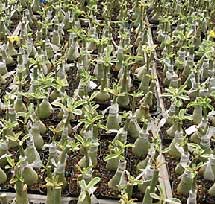 |
Recently grafted Adeniums beginning to grow: such single grafts on vigorous seedlings grow rapidly. |
In Thailand and Taiwan they prefer to use somewhat bigger plants as rootstock.
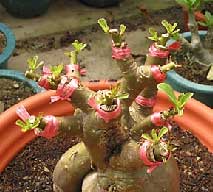 |
A large old caudex is used as rootstock in Taiwan: small scion pieces are used. Such plants may not grow very rapidly but the whole system quickly produces a specimen Adenium, which when in bloom looks spectacular and sell for high prices in the local market. |
Our system gives a single joint low on the plant-this is aesthetically more pleasing and since most of the growth is from the scion, the chances of the seedling rootstock growing and competing with the selected top are low after the initial growing period. Also the vigor of the seedling tends to give very healthy growth in the scion.
Cleft grafting is commonly used. It is possible to graft very young seedlings as scions using this method.
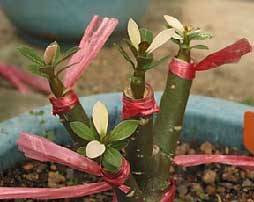 |
Really expert Taiwanese growers are able to graft month old seedlings onto old mature branches: here four Adenium somalense seedlings showing variegation are grafted to boost growth. |
Plastic tape is used to tie the union and hold it together till well bonded. A plastic bag tied over the graft keeps the scion turgid till the connection is established.
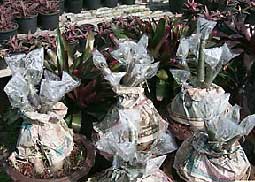 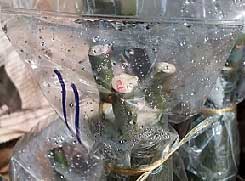 |
| Adenium grafting in Thailand: the grafted ends are covered with a plastic bag. Often, in the relatively cloudy climate the plants are left in the open: the plants "sweat" a lot under the plastic but seem to take the heat without any problems. Note the wrapping of the caudex to prevent sun scorch. |
POST GRAFTING CARE
Once the grafting is done, the plant needs to be kept shaded: this is to keep it cool under warm conditions and prevent over heating inside the plastic bag.
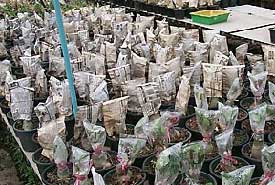 |
Other Thai growers prefer to cover the plastic bags with an additional newspaper bag to protect it from the sun. This is done more with younger plants. |
Depending on the temperatures, it will take between 10 to 30 days for the graft union to take; it's best to remove the plastic bag as soon as possible. Return the plant to full sun too: if it's been under shade for a while it will need a little gradual acclimatizing to full sun.
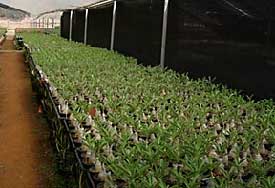 |
Our grafts after several months, now fully sun hardened, growing and leafing out vigorously. |
The next things to keep in mind: remove the grafting tape once the union is really well formed: the reason for this is that the caudex, as it continues to expand, tends to split up at the top of the wound, giving a less cosmetic union. Keeping the tape on does no harm till it is really biting into the tissue and it does result in a cleaner union.
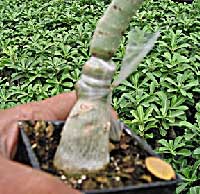 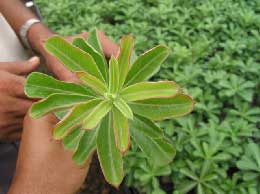 |
| An extreme case of graft tie girdling: this graft was not opened for several months. The plastic tie has eaten into the stem of both, the scion and the rootstock. The top shows general chlorosis, smaller leaves with red tinting and other signs of malnutrition. The plant recovered fully after removal of the tie and repotting. |
In the meanwhile, there are likely to be sprouts coming from the root stock: these need to be trimmed from the base with a clean, sharp knife: its not a good idea to "rub it off" like one would with a regular plant: for one thing, the sprouts then tend to come back with renewed vigor and second, of course, is that you will have a very bitter thumb indeed!
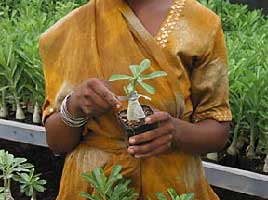 |
Shoots from the rootstock need to be meticulously removed with a knife. Shoots coming from very near the graft union and beneath the plastic tie are the most difficult to spot as rootstock growth. |
Grafting on Nerium:
Use of Nerium cuttings as rootstock was developed in Germany in the 80's. The reason for this was probably the difficulty in obtaining a large number of Adenium seedlings as well as the fact that Nerium roots are much more cold resistant. From the little experience we have with Nerium, I can say that grafts on this are remarkably floriferous (maybe because there is no caudex to store food in and all of it gets channeled into flowering). Disadvantages include the fact that it looks terrible, at least to me. If you wanted just a flowering pot plant, especially under temperate conditions, there are hundreds of equally good or better candidates. An Adenium must look like an Adenium.
Cuttings:
Rooting Adenium cuttings is not too difficult but results are often mixed; I feel there are a lot of clonal differences in speed and ability to root. We root all the material we prune off our mother plants- these then produce some additional seeds.
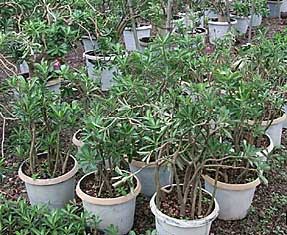 |
Trimmings from our mother plants are rooted 7-10 to a pot. Even if several of them rot, the rest root and provide additional plants for seed setting. |
Rooting cuttings was the only commercial way to propagate Adeniums till seed became available. The old variety called "Singapore", found all over S.E. Asia, is an easily rooting variety with long stems and large flowers. It is still used as a bedding plant in beds and boxes. It does much better than specimen plants grown from seed since it is a variety selected for its application and all propagation material is mature.
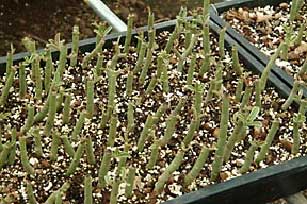 |
We rooted these cuttings of the variegated Adenium cultivar Daang Nab Anant when we ran out of rootstock. They rooted quite easily in our regular potting medium. |
I know of two modern pot plant producers who use cuttings as a propagation material to produce Adenium flowering pot plants- one in The Netherlands and another in Israel. I know for sure that the Dutch grower has his own selection with small shiny leaves and medium sized flowers in clusters. Pots are produced using several cuttings per pot. Of course there is no caudex but it still doesn't look as bad as a Nerium graft.
The big disadvantage of growing commercial quantities from cuttings is the need for large amounts of propagation material- for most cultivars the availability of clonal material is limited and grafting small pieces is the only practical option.
Root Cuttings:
Swollen roots of Adenium swazicum will, in time, sprout shoots. Though interesting, it is not a viable means of propagation. I discovered this ability after a large A. swazicum plant had rotted and the roots were intact and still buried in the medium- they started sprouting some months later. Though hardly a recommended route for propagation, this does show some possibilities.
Air Layering:
Airlayering is a better, faster and safer system than stem cuttings. It is still used to propagate large branches for landscape use in S.E. Asia. I have seen air layered branches with small coir filled root balls for sale in bulk at Bangkok's Chatuchak Weekend Market, most likely for landscape applications.
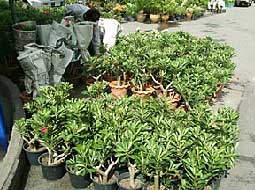 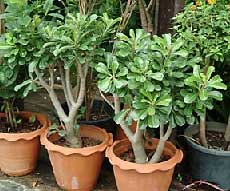 |
| (left) Cheap, large sized Adeniums mass produced by air layering on sale at Chatuchak in Bangkok. (right) Better shaped plants for retail sales outside Chatuchak. |
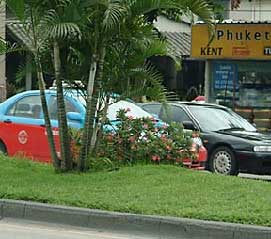 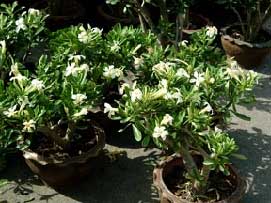 |
| (left) Adeniums like the above in a bed on a traffic divider in Bangkok. (right) Recently some old white clones have become common enough to be propagated by air layering and sold at Chatuchak. |

© Copyright Tropica Nursery 2026. All Rights Reserved.
Maintained by MiracleworX Web Designer Mumbai